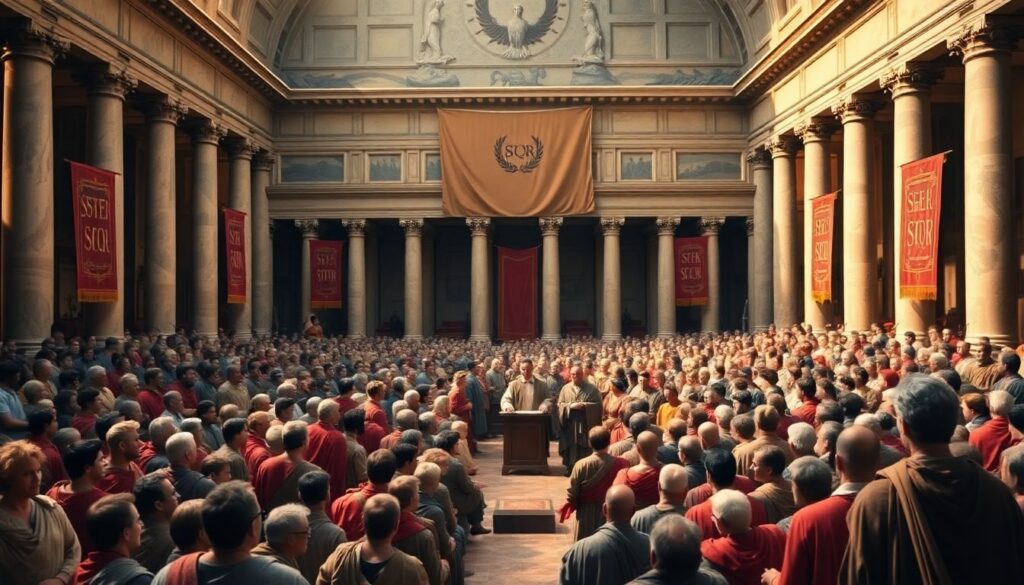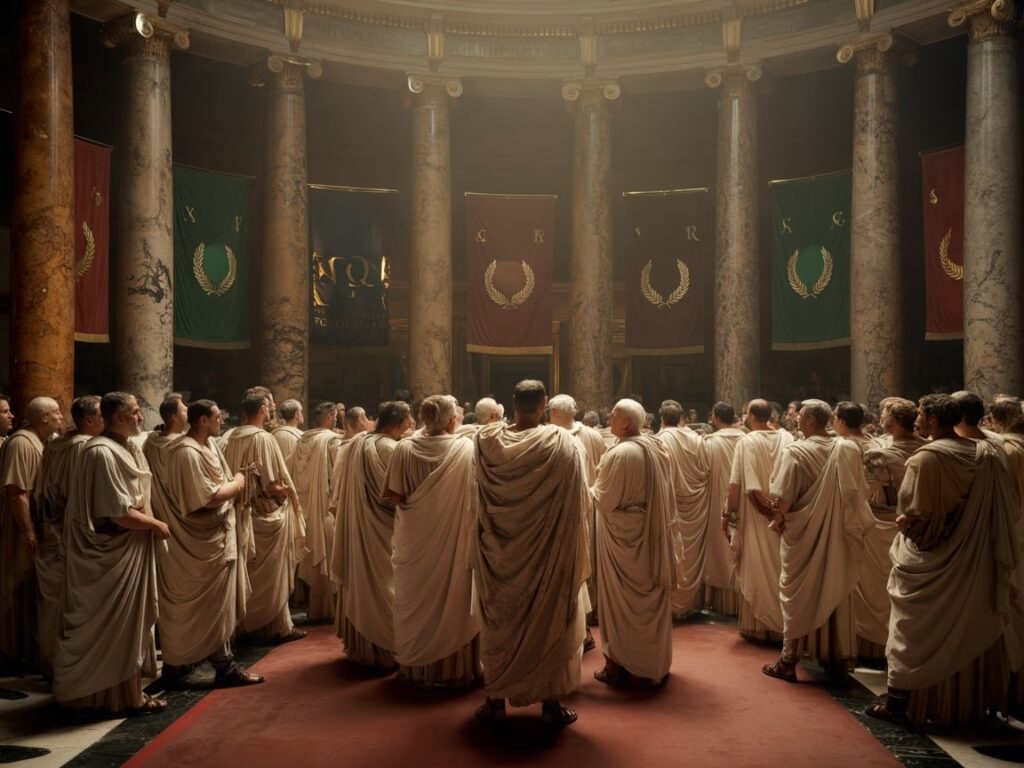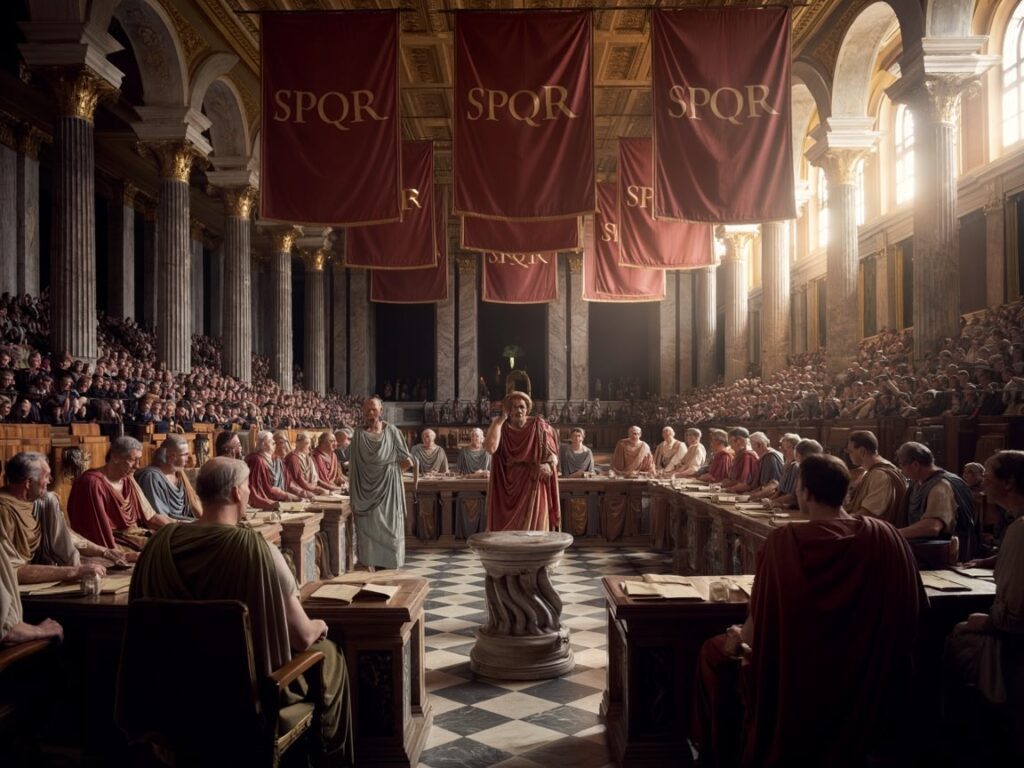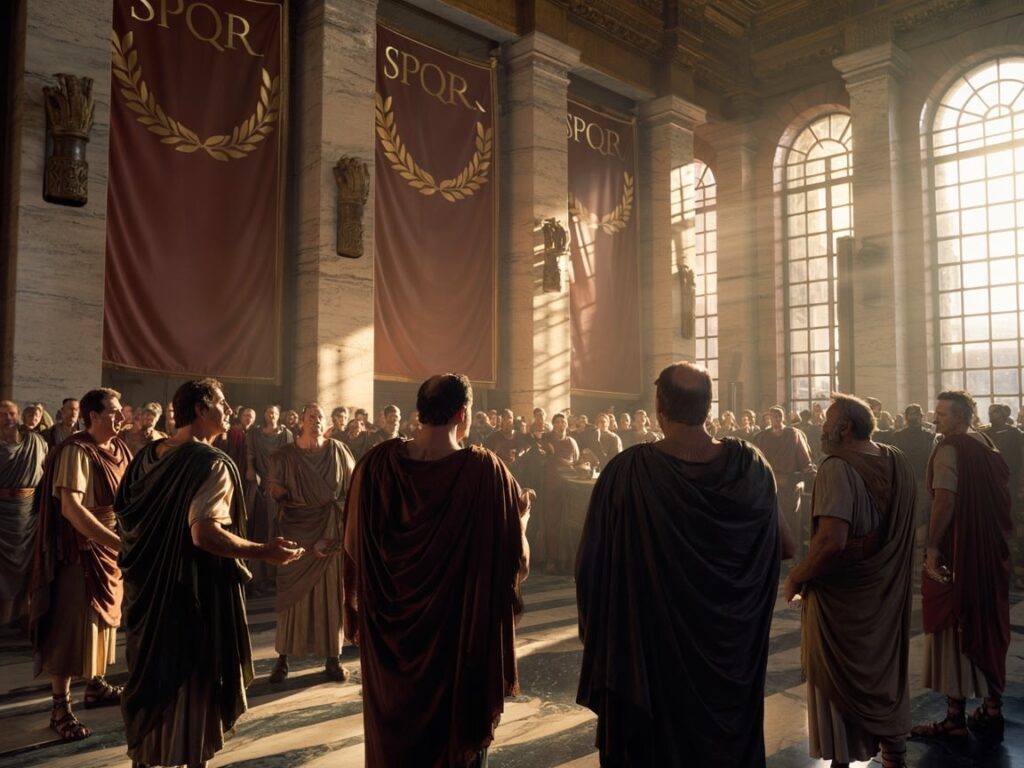Few institutions of the ancient world have had an influence as profound and enduring as the Roman Senate. For centuries, this body of roughly six hundred men, drawn from the aristocratic families of Rome, shaped the destiny of a city-state that transformed into a world empire. The Senate was not merely a council of dignitaries or a ceremonial relic of monarchy; it was the living core of the Roman Republic.
The famous abbreviation SPQR—Senatus Populusque Romanus, “the Senate and People of Rome”—reflected the partnership between this aristocratic council and the Roman citizens. Together, they governed more of the known world than any other political structure of their time. The Senate embodied tradition, continuity, and collective wisdom; the assemblies of the Roman people represented democratic energy, mass participation, and the military force of citizen soldiers.
Yet the Senate’s survival and influence rested on subtle balances. It did not command armies, nor did it enforce laws directly. Its power was moral, symbolic, and institutional—a concept the Romans themselves called auctoritas. Paired with, and often contrasted against, the executive power of imperium, which was entrusted to magistrates and military leaders, this distinction underpins the whole story of Rome’s political evolution.
This article explores the Roman Senate in depth: its symbols and concepts; the legendary debates of figures like Cato, Cicero, and Caesar; its transformation across the Republic and Empire; and the key moments that determined its fate. We will also trace its enduring legacy, which still shapes political institutions today.

SPQR: The Shared Identity of Rome
More Than an Acronym
Throughout the Roman world, from triumphal arches to legionary standards, the Latin letters SPQR carried weight and meaning. They were a visible shorthand for Rome’s political order: a system built on the cooperation between the Senate (senatus) and the Roman citizens (populus Romanus).
On the surface, this formulation projected unity. It proclaimed to allies and enemies alike that Rome was not ruled by a monarch or a tyrant, but by the collective will of its ruling council and its people. The Roman Senate expressed continuity with the ancient traditions of patrician leadership, while the people’s assemblies expressed a measure of collective sovereignty. Together, these two pillars defined the civic life of Rome.
The Tension Within
Yet this unity was fragile. The Senate was aristocratic by nature. Its membership was limited to wealthy men—landowners, former magistrates, and elite families who traced their prestige back to the earliest days of the Republic. Meanwhile, the people, assembled in voting tribes or centuries, often pressed for more direct influence, especially under the guidance of tribunes of the plebs.
The balance implied by SPQR was always precarious. From the Gracchi brothers in the second century BCE through the populist politics of Julius Caesar, repeated clashes between Senate and people pushed the Republic toward crisis. In reality, SPQR was not a perfectly harmonious partnership, but an uneasy compromise between aristocratic dominance and popular sovereignty.
Auctoritas and Imperium: The Twin Languages of Power
The Distinction at the Heart of Roman Politics
To grasp the Senate’s role, one must understand the Roman distinction between auctoritas and imperium.
- Imperium referred to direct executive and military power. It was the authority to command armies, to enforce decisions, and to exercise judicial control. Always temporary, imperium was conferred on magistrates like consuls, praetors, and occasionally dictatorial appointees.
- Auctoritas, by contrast, was an intangible but critical concept: moral authority, legitimacy, the weight of social prestige and ancestral tradition. It resided primarily in the Senate, which issued senatus consulta—advisory decrees that guided magistrates but did not bind them legally.
The Senate’s Power Without Force
The Senate had no police force, no standing army, and no executive mechanism. It relied on persuasion, prestige, and consensus. Yet its advisory decrees almost always carried the weight of law because magistrates—ambitious men drawn from the same aristocratic circles—rarely dared to oppose its will. The Senate thus wielded tremendous practical control without possessing the means of coercion.
This paradox—immense influence without legal compulsion—was both the Senate’s strength and its fatal vulnerability. At times of stability, its moral authority was sufficient. At times of crisis, however, ambitious generals could bypass its advisory role by appealing directly to the people or to military loyalty, using their imperium to overshadow the Senate’s auctoritas.
Crisis and the Struggle Between Concepts
The late Republic is best understood as a prolonged struggle between auctoritas and imperium. Reformers, demagogues, and warlords sought direct power by undermining senatorial consensus. Gaius Marius used his military influence to redefine careers for ambitious citizens. Lucius Cornelius Sulla, marching on Rome with his legions, re-imposed the Senate’s authority by violence. Finally, Julius Caesar fused imperium and personal charisma to eclipse senatorial power altogether.
The political vocabulary of auctoritas versus imperium thus shaped Rome’s fall into civil war and prepared the stage for Augustus, who cleverly merged both under his carefully crafted role as princeps.

Legendary Debates of the Senate
Cato the Elder: Tradition Incarnate
In the second century BCE, Rome’s Senate was personified by Marcus Porcius Cato, often known as Cato the Elder or Cato the Censor. A man of rustic austerity, he cherished the mos maiorum—the ancestral customs—and staunchly resisted foreign luxury creeping into Rome.
Cato’s speeches were not riddled with flowery rhetoric but with blunt force and unwavering convictions. His famous refrain, “Carthage must be destroyed,” underscored his commitment to eliminating enemies of Rome with merciless determination. For Cato, the Senate existed to safeguard discipline, simplicity, and military supremacy. His presence gave the institution its aura of incorruptible gravitas.
Cato the Younger vs. Caesar: An Ideological Clash
A century later, another Cato—Cato the Younger, also known as Cato of Utica—carried this mantle of senatorial integrity into one of the Republic’s most turbulent eras. His foe was none other than Julius Caesar.
Cato represented uncompromising defense of republican tradition, while Caesar embodied ambition, reform, and charismatic populism. The Senate became their battleground.
- Cato demanded unwavering adherence to aristocratic precedence, suspicion toward demagogues, and unyielding austerity.
- Caesar, by contrast, courted the masses, advocated for land redistribution, and used his military victories to enhance his political power.
The sight of these two figures clashing in the Senate encapsulated Rome’s crisis: a battle of ideals over whether Rome’s destiny lay in aristocratic tradition or in individual leadership elevated above collective governance.

Key Moments in Senatorial History
Cicero vs. Catiline: A Senate Saved by Oratory
One of the most dramatic days in the Senate took place in 63 BCE, during the consulship of Marcus Tullius Cicero. The patrician but impoverished Lucius Sergius Catilina had conspired to overthrow the government by rallying indebted aristocrats, desperate veterans, and political malcontents.
Cicero, informed of the plot, convened the Senate and delivered his first Catilinarian Oration. With Catiline himself seated inside the chamber, Cicero thundered: “How long, Catiline, will you abuse our patience?” It was a rhetorical ambush, morally isolating the conspirator in front of Rome’s political elite.
The speech crystallized the Senate’s role as the stage upon which words could shape destinies. Catiline was denounced, his conspiracies exposed, and the Republic preserved—for the time being. The moment illustrates how the Senate functioned less as a legislative agency than as a theater for performance, persuasion, and moral sanction.
The Last Senate Before Caesar’s Assassination
Eighty years later, in March 44 BCE, the Senate was again at the center of crisis. Julius Caesar, having defeated Pompey and consolidated power, had been appointed dictator perpetuo—dictator for life. While Caesar claimed he was preserving the Republic, his dominance over magistracies, elections, and legislation made it clear the Senate had lost its independence.
The conspirators—Brutus, Cassius, and a few dozen senators—prepared to act. Ironically, the assassination itself took place not in the Senate’s main building (which was under renovation) but in the Theater of Pompey. Still, the act was conceived as a senatorial defense of liberty: senators striking down a would-be king.
Instead of restoring the Senate, however, Caesar’s death unleashed renewed civil wars. Within two decades, Augustus would arise as the uncontested princeps, integrating the Senate into his imperial framework.
Transformation Under Augustus
Augustus, master of political theater, understood that abolishing the Senate would alienate Rome’s aristocracy. Instead, he reformed it.
He reduced its membership from a bloated 1,000 senators to a disciplined 600, restoring exclusivity and luster. He accorded the Senate official duties, such as supervising provinces considered peaceful and unmilitarized, and administering certain financial responsibilities. Senators still debated, still voted decrees, and still enjoyed a lifestyle of prestige.
But the reality was clear: the Senate had been domesticated. Its independent auctoritas was absorbed into Augustus’s personal authority. While he styled himself as the “first among equals,” the Senate of the Empire was no longer a cockpit of decision-making—it was an honored but tamed institution within the larger machinery of imperial rule.

The Senate’s Paradoxical Legacy
Influence Without Commands
The Roman Senate illustrates a paradox at the heart of political power: an institution can govern effectively without coercive force if it possesses legitimacy, prestige, and consensus. For centuries, its auctoritas enabled Rome to expand across Italy, then the Mediterranean, and then the wider world.
Yet this same reliance on intangible authority rendered it vulnerable. Men who could appeal directly to legions disrupted the balance, and once auctoritas was eclipsed by brute imperium, the Senate became secondary.
Model for Later Institutions
Nevertheless, the Senate’s example has echoed throughout history. Aristocratic upper chambers, councils of elders, and modern senates—from Britain’s House of Lords to the American Senate—carry conceptual ancestry from this Roman institution. Even the word “Senate,” derived from senex (“old man”), reflects continuity of terminology.
The Enduring SPQR
To this day, the letters SPQR adorn the monuments, fountains, and municipal emblems of the city of Rome. They are reminders of a civic identity forged two thousand years ago—an identity where six hundred men ruled, debated, and steered the fate of the Mediterranean world.
Conclusion: The Senate as Stage and Symbol
The Roman Senate was never merely a bureaucratic organ. It was a stage on which personalities clashed, where orators shaped destinies, and where traditions tried—and failed—to resist the pull of ambition.
- Cicero’s words against Catiline saved a Republic, if only in temporary reprieve.
- Cato’s frugality and Caesar’s daring collided in ideological duel.
- Augustus preserved the Senate’s prestige while hollowing its independence.
The story of the Senate is the story of Rome itself: great, fragile, adaptable, and contradictory. It shows that political authority is built not only on swords and decrees but on shared legitimacy, ritual, and the weight of collective voices.
Six hundred men once ruled the world, not because they commanded, but because they persuaded; not because they wielded absolute power, but because they embodied the authority of an entire civilization.

